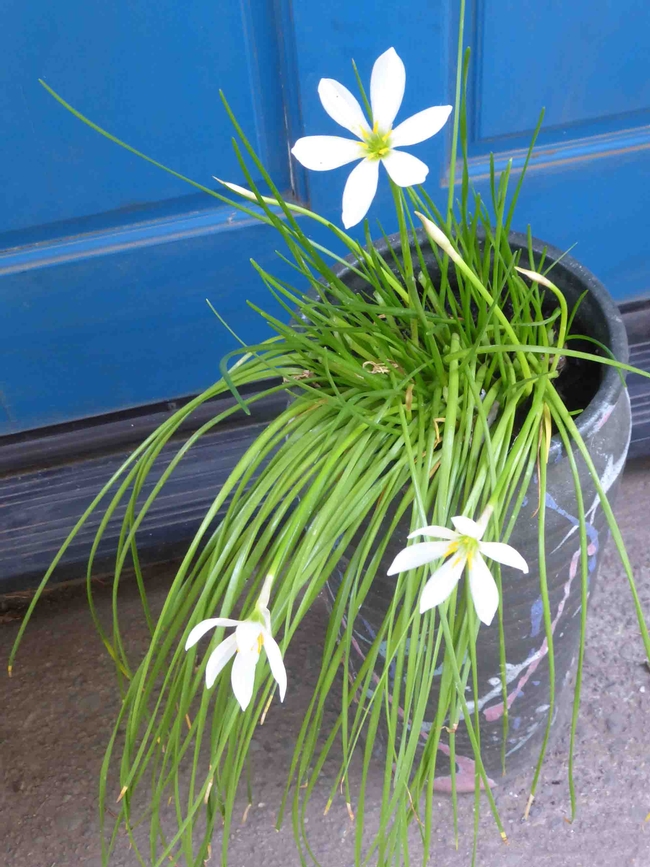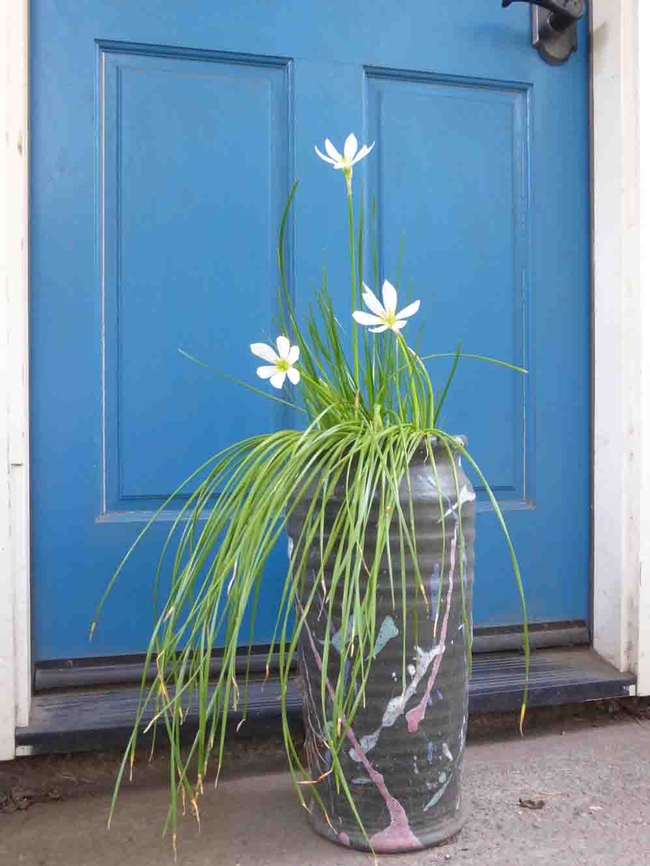Lilies are monocotyledons, plants which have flower parts in multiples of three, parallel leaf veins and fibrous, branching roots. They often have strap-like leaves in a clump at the base of the plant, and flowers on long stalks which tower over the leaves and wave in the breeze. Tulips, onions, and garlic are also monocotyledons. By definition, a monocot has only one cotyledon (seed leaf), whereas a dicot has two cotyledons; dicot flowers tend to have petals in multiples of four or five, branching leaf veins, and tap roots (one large main root with side branches). Common examples of dicots are roses, peas, and daisies.

Crinum ‘Ellen Bosanquet'
“Crinum” comes from a Greek word meaning “lily.” The “Ellen Bosanquet” crinum was hybridized in the early twentieth century and named by the Florida-based plant breeder after his wife.
Crinum bulbs are easily grown in organically rich, moist, well-drained soil in full sun to light shade, but will survive drought and neglect. Leaves shoot up in strap-shaped mounds, one to two feet wide and two to three feet high. Deep rose-colored blooms appear from July to August on three- to four-foot high stalks, each with clusters of four-to six-inch trumpet-shaped flowers. The flowers are showy and have a spicy fragrance. When planting, set bulb in the ground with the neck exposed. Increase watering in spring as the plant shows signs of new growth. After bloom, reduce irrigation so that the soil dries out between waterings. Propagate by bulblets in spring, although plants can be shared almost any time. Crinum plants, if disturbed, may not bloom for another two to three years. When grown in the ground year-round, they spread to form large colonies which can tolerate much adversity and live seemingly forever. Bulbs tend to pull themselves deeper in the soil over time.
Zephyranthes candida

Plant rain lilies from bulbs in the early spring, 2 to 3 inches deep and 3 to 4 inches apart, or plant them with their foliage at any time.
Rain lilies reseed prolifically and produce abundant small bulbs.
Oxblood Lilies (Rhodophiala bifida)
Oxblood Lilies are also called schoolhouse lilies, or hurricane lilies because they bloom in September. They are native to Argentina and Uruguay and were first introduced into Texas in the late nineteenth-century by an early German colonist. These amaryllis relatives have long, narrow leaves and slender flower stems topped by trumpet-shaped blooms of a deep, electric red. Flowers are two-inch trumpets similar to those of daylilies, and bloom on one-foot- high stalks. Like the belladonna lily (the “naked lady” amaryllis) Oxblood lilies produce clumps of strappy leaves in fall and winter which die down by early summer; the flowering stalks that appear in September are accompanied by two long leaves, and more leaves appear after the flowering stalks die. This growth pattern allows double use of your landscape space. Plant oxblood lilies in sun or part shade in almost any well-draining soil. Water occasionally in summer. They can be moved any time from early fall to late spring, usually without affecting the following autumn's bloom. Plant three or four inches deep, with necks protruding from the soil, in drifts. Oxblood lilies typically thrive from 50 to 100 years and multiply prolifically over that period. They do not need division and the bulbs will migrate deeper over time.
Because they bloom successively, planting crinum “Ellen Bosanquet,” rain lilies, and oxblood lilies in your garden ensures flowering lilies from July through September – a very cheering sight in our hot, dry summer.
UC Master Gardeners of Butte County are part of the University of California Cooperative Extension (UCCE) system. To learn more about us and our upcoming events, and for help with gardening in our area, visit our website. If you have a gardening question or problem, email the Hotline at mgbutte@ucanr.edu (preferred) or call (530) 538-7201.